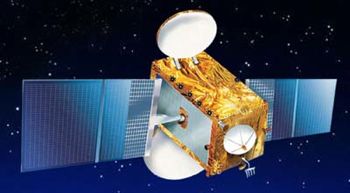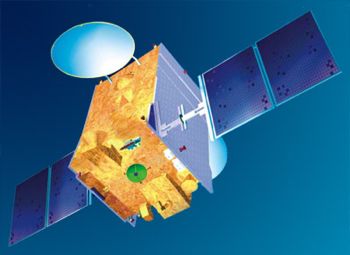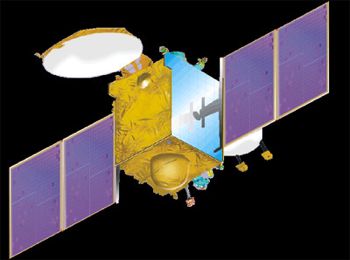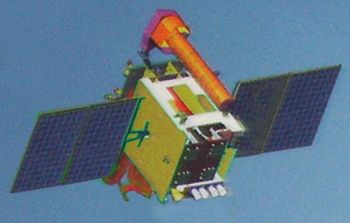
Home - Search - Browse - Alphabetic Index: 0- 1- 2- 3- 4- 5- 6- 7- 8- 9
A- B- C- D- E- F- G- H- I- J- K- L- M- N- O- P- Q- R- S- T- U- V- W- X- Y- Z
I-2K
 Gsat 2 Credit: Manufacturer Image |
AKA: Hylas;Insat. Status: Operational 2001. First Launch: 2001-04-18. Last Launch: 2015-08-27. Number: 11 .
More at: I-2K.
| GSat 1 Experimental Communication satellite built by ISRO for Insat, India. Launched 2001. Used the I-2K (I-2000) Bus bus. |
| GSat 2 Experimental Communication satellite built by ISRO for Insat, India. Launched 2003. Used the I-2K (I-2000) Bus bus. |
| GSat 3 (EduSat) Null |
| Insat 4C, 4CR Communication satellite built by ISRO for Insat, India. Launched 2006 - 2007. Used the I-2K (I-2000) Bus bus. |
| GSat 4 (HealthSat) Null |
| HYLAS 1 Communication satellite built by EADS Astrium (payload), ANTRIX/ISRO (bus) for Avanti Communications Group plc, UK. Launched 2010. Used the I-2K (I-2000) Bus bus. |
| GSat 5P Communication satellite built by ISRO for Insat, India. Launched 2010. Used the I-2K (I-2000) Bus bus. |
| GSat 7, 7A (Insat 4F, Rukmini) Null |
| GSat 14 Communication satellite built by ISRO for Insat, India. Launched 2014. Used the I-2K (I-2000) Bus bus. |
| GSat 6, 6A / Insat 4E Null |
| Insat 3DR, 3DS Meteorology satellite built by ISRO for Insat, India. Launched 2016. Used the I-2K Bus bus. |
| GSat 9 (South Asian Satellite) Null |
| GSat 5 (Insat 4D) Null |
Family: Communications. Country: India. Launch Vehicles: PSLV, Ariane 5, GSLV, Ariane 5ECA, GSLV Mk II. Launch Sites: Sriharikota PSLV, Kourou ELA3, Sriharikota SLP. Bibliography: 6579, 12628, 12629, 12630, 12631, 12632, 12633, 12634, 12635.
 | Gsat 1 Credit: Manufacturer Image |
 | Gsat 14 Credit: Manufacturer Image |
 | EDUSAT Credit: Manufacturer Image |
 | Gsat 5P Credit: Manufacturer Image |
 | Hylas 1 Credit: Manufacturer Image |
 | Insat 4C Credit: Manufacturer Image |
 | Gsat 7 Credit: Manufacturer Image |
2001 April 18 - . 10:13 GMT - . Launch Site: Sriharikota. Launch Complex: Sriharikota PSLV. Launch Vehicle: GSLV.
- GSAT-1 - .
Payload: GramSat. Mass: 1,530 kg (3,370 lb). Nation: India.
Agency: ISRO.
Program: Insat.
Class: Communications.
Type: Civilian communications satellite. Spacecraft: I-2K.
USAF Sat Cat: 26745 . COSPAR: 2001-015A. Apogee: 35,814 km (22,253 mi). Perigee: 33,825 km (21,017 mi). Inclination: 0.00 deg. Period: 1,387.00 min.
Experimental Rural Communications satellite. Launch delayed following pad abort on March 28. First launch of the Indian GSLV launch vehicle. GSat 1 was an Indian, 1500 kg scaled-dow) test model of a future geosynchronous communications spacecraft with a 440 N ISRO liquid apogee motor, and S-band and C-band ommunications transponders, similar to the Insat-2 satellites. The motor for the cryogenic, hydrogen-oxygen upper stage had been purchased from Russia but the design had never flown in space before. The stage cut off without providing the required delta-V - preliminary analysis revealed a shortfall of 0.5% in the thrust. An attempt was made to reach a usable orbit using the station-keeping motor of the GSAT satellite itself. After a series of burns, GSat 1 ran out of propellant - 10 kg more fuel would have been required to reach a stationary orbit. In the end, the parameters of the drifting (about 13 deg/day) orbit were period 23 hours, apogee 35,665 km, perigee 33,806 km, and inclination 0.99 deg. The fully functional transponders and transmitters on board were deactivated on instructions of the International Telecommunications Union. As of 4 September 2001 located at 54.88 deg E drifting at 13.212 deg E per day. As of 2007 Mar 10 located at 50.16W drifting at 12.778E degrees per day.
2003 May 8 - . Launch Site: Sriharikota. Launch Complex: Sriharikota PSLV. Launch Vehicle: GSLV.
- GSAT-2 - .
Payload: GramSat. Mass: 1,825 kg (4,023 lb). Nation: India.
Agency: ISRO.
Program: Insat.
Class: Communications.
Type: Civilian communications satellite. Spacecraft: I-2K.
USAF Sat Cat: 27807 . COSPAR: 2003-018A. Apogee: 35,790 km (22,230 mi). Perigee: 35,782 km (22,233 mi). Inclination: 0.00 deg. Period: 1,436.10 min.
Experimental Rural Communications. Launch delayed from original target of late 2001, then October 2002, then February 2003. The satellite carried four C-band transponders, two Ku-band transponders and a Mobile Satellite Service (MSS) payload operating in S-band and C-band for forward link and return link respectively. GSAT-2 also carried four piggyback experimental payloads: Total Radiation Dose Monitor (TRDM), Surface Charge Monitor (SCM), Solar X-ray Spectrometer (SOXS) and Coherent Radio Beacon Experiment (CRABEX). As of 2007 Mar 10 located at 47.97E drifting at 0.005E degrees per day.
2004 September 20 - . 10:31 GMT - . Launch Site: Sriharikota. Launch Complex: Sriharikota PSLV. Launch Vehicle: GSLV.
- GSAT-3 / Edusat - .
Payload: GramSat. Mass: 1,950 kg (4,290 lb). Nation: India.
Agency: ISRO.
Program: Insat.
Class: Communications.
Type: Civilian communications satellite. Spacecraft: I-2K.
USAF Sat Cat: 28417 . COSPAR: 2004-036A. Apogee: 35,801 km (22,245 mi). Perigee: 35,772 km (22,227 mi). Inclination: 0.10 deg. Period: 1,436.10 min.
Gsat-3 / Edusat was the first Indian satellite built exclusively for the educational sector. It was mainly intended to meet the demand for an interactive satellite based distance education system for India. Edusat was launched into a geosynchronous transfer orbit by its launch vehicle. Edusat was to reach geostationary orbit by firing, in stages, its on board Liquid Apogee Motor (LAM). In geostationary orbit the satellite was to be co-located with Kalpana-1 and Insat-3C satellites at 74 deg East longitude.
Compared to earlier satellites in the Insat series, Edusat used several new technologies. The spacecraft was built around the I-2K standardised spacecraft bus. It had a multiple spot beam antenna with a 1.2 m reflector to direct Ku band spot beams, a dual core bent heat pipe for thermal control, high efficiency multi-junction solar cells and an improved thruster configuration for optimised propellant use for orbit and orientation maintenance. The satellite used radiatively cooled Ku-band Travelling Wave Tube Amplifiers and a dielectrically loaded C-band demultiplexer for its communication payloads. Edusat carried five Ku-band transponders providing spot beams, one Ku-band transponder providing a national beam and six Extended C-band transponders with a national coverage beam. It was to join the Insat system that already provided more than 130 transponders in C-band, Extended C-band and Ku-band for a variety of telecommunication and television services.
First operational flight of launch vehicle. Launch delayed from July, August and September 10. Dry mass 820 kg. As of 2007 Mar 9 located at 73.92E drifting at 0.006W degrees per day.
2006 July 10 - . 12:08 GMT - . Launch Site: Sriharikota. Launch Complex: Sriharikota SLP. Launch Vehicle: GSLV. FAILURE: One of the liquid-fueled strap-on motors failed to develop thrust. By 40 seconds after launch the GSLV had veered outside of the launch corridor and the destruct signal was sent.. Failed Stage: 0.
- Insat 4C - . Mass: 2,168 kg (4,779 lb). Nation: India. Agency: ISRO. Program: Insat. Class: Communications. Type: Civilian communications satellite. Spacecraft: I-2K.
2007 September 2 - . 12:50 GMT - . Launch Site: Sriharikota. Launch Complex: Sriharikota SLP. Launch Vehicle: GSLV.
- Insat 4CR - . Mass: 2,130 kg (4,690 lb). Nation: India. Agency: ISRO. Program: Insat. Class: Communications. Type: Civilian communications satellite. Spacecraft: I-2K. USAF Sat Cat: 32050 . COSPAR: 2007-037A. Apogee: 35,790 km (22,230 mi). Perigee: 35,221 km (21,885 mi). Inclination: 0.10 deg. Period: 421.80 min. Ku-band television satellite..
2010 April 15 - . 10:57 GMT - . Launch Site: Sriharikota. LV Family: GSLV. Launch Vehicle: GSLV Mk II. FAILURE: Third stage failure..
- Gsat 4 - . Nation: India. Agency: ISRO. Class: Communications. Type: Communications satellite. Spacecraft: I-2K. Failed to orbit due to third stage failure. Ka-band communications satellite with a GPS-augmentation navigation transmitter..
2010 November 26 - . 18:39 GMT - . Launch Site: Kourou. Launch Complex: Kourou ELA3. LV Family: Ariane 5. Launch Vehicle: Ariane 5ECA.
- Hylas 1 - . Mass: 2,570 kg (5,660 lb). Nation: UK. Manufacturer: ISRO. Class: Communications. Type: Civilian communications satellite. Spacecraft: I-2K. USAF Sat Cat: 37237 . COSPAR: 2010-065A. Apogee: 36,052 km (22,401 mi). Perigee: 35,522 km (22,072 mi). Inclination: 0.10 deg. Period: 1,436.10 min. Ka band communications; 2570 kg loaded / 1125 kg unfuelled..
2010 December 25 - . 10:34 GMT - . Launch Site: Sriharikota. Launch Complex: Sriharikota SLP. Launch Vehicle: GSLV. FAILURE: Destroyed at T+60 seconds after guidance commands from on-board computer to steering system of strapon boosters were cut off.. Failed Stage: 0.
- Gsat 5P - . Mass: 2,310 kg (5,090 lb). Nation: India. Program: Insat. Class: Communications. Type: Civilian communications satellite. Spacecraft: I-2K. Vehicle reached only 15 km. First use of stretched cryogenic third state. Gsat-5P communications satellite destroyed..
2013 August 29 - . 20:30 GMT - . Launch Site: Kourou. Launch Complex: Kourou ELA3. LV Family: Ariane 5. Launch Vehicle: Ariane 5ECA.
- GSAT-7 - . Payload: Insat 4F. Mass: 2,650 kg (5,840 lb). Nation: India. Class: Communications. Type: Communications satellite. Spacecraft: I-2K. USAF Sat Cat: 39234 . COSPAR: 2013-044B. Apogee: 35,811 km (22,251 mi). Perigee: 35,762 km (22,221 mi). Inclination: 0.0400 deg. Period: 1,436.09 min. Communications satellite for the Indian Navy..
2014 January 5 - . 10:48 GMT - . Launch Site: Sriharikota. Launch Complex: Sriharikota SLP. LV Family: GSLV. Launch Vehicle: GSLV Mk II.
- GSAT-14 - .
Mass: 1,982 kg (4,369 lb). Nation: India.
Class: Communications.
Type: Communications satellite. Spacecraft: I-2K.
USAF Sat Cat: 39498 . COSPAR: 2014-001A. Apogee: 35,789 km (22,238 mi). Perigee: 35,784 km (22,235 mi). Inclination: 0.0800 deg. Period: 1,436.09 min.
Carried C and Ku band communications payloads, and Ka-band beacons for a propagation study. The launch vehicle put the satellite in an initial 182 km x 35,755 km x 19.4 deg geostationary transfer orbit. By January 7 its onboard apogee engine had placed it in a 32,543 x 35,741 km x 0.7 deg subsynchronous orbit on the way to GEO. By February 4 it was on station at 73.9 deg E.
2015 August 27 - . 11:22 GMT - . Launch Site: Sriharikota. Launch Complex: Sriharikota SLP. LV Family: GSLV. Launch Vehicle: GSLV Mk II.
- GSAT-6 - . Mass: 2,117 kg (4,667 lb). Nation: India. Class: Communications. Type: Communications satellite. Spacecraft: I-2K. USAF Sat Cat: 40880 . COSPAR: 2015-041A. Apogee: 35,831 km (22,264 mi). Perigee: 35,742 km (22,209 mi). Inclination: 1.03 deg. Period: 1,436.10 min. Military communications satellite with S-band and C-band payload for use by the Indian Armed Forces. Geosynchronous orbit stationed at 83E.
Back to top of page
Home - Search - Browse - Alphabetic Index: 0- 1- 2- 3- 4- 5- 6- 7- 8- 9
A- B- C- D- E- F- G- H- I- J- K- L- M- N- O- P- Q- R- S- T- U- V- W- X- Y- Z
© 1997-2019 Mark Wade - Contact
© / Conditions for Use